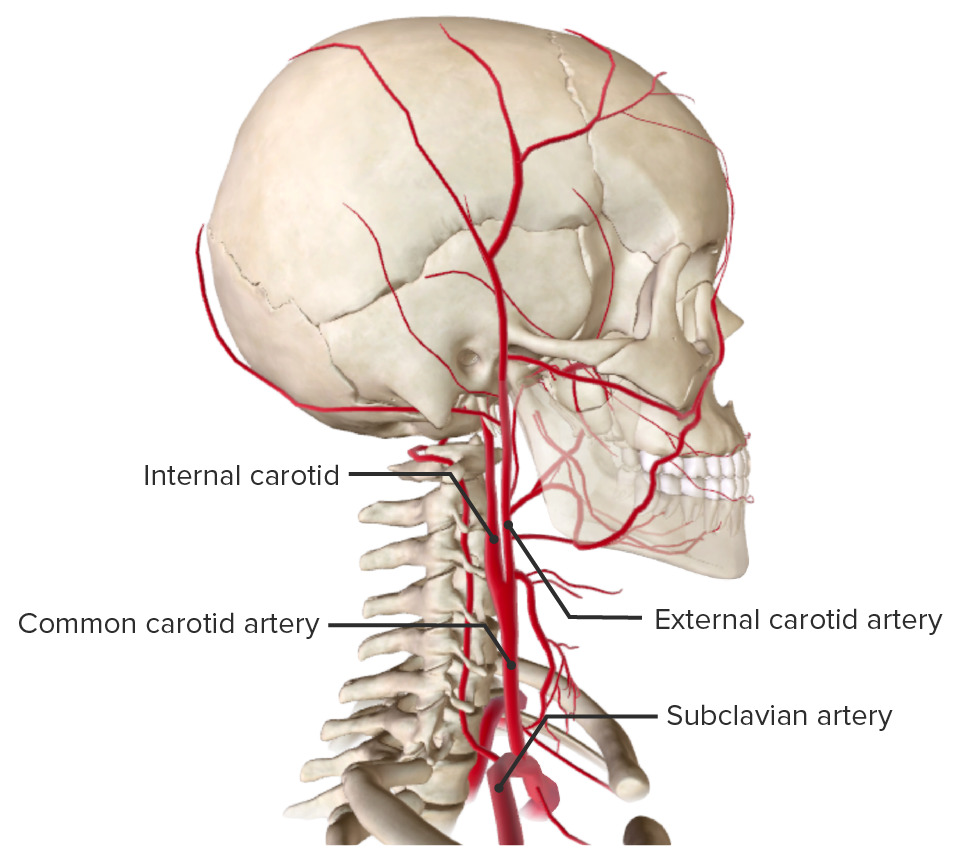Playlist
Show Playlist
Hide Playlist
Clinical Correlation: Superficial Temporal Arteritis and Carotid Artery Disease – Carotid and Subclavian Arteries
-
Slides Carotid and subclavian arteries.pdf
-
Download Lecture Overview
00:01 Now, for a clinical correlation, this clinical correlation relates to the superficial temporal artery. 00:09 And there is a condition referred to as superficial temporal arteritis. 00:14 In this condition, the superficial temporal artery is going to be inflamed. 00:20 When it becomes inflamed, it will have some associated symptoms. 00:26 One of the symptoms of this inflammatory state is a throbbing headache on the involved site. 00:34 So here, we’re looking at the left superficial temporal artery. 00:37 So if this is the inflamed artery then that throbbing headache will be on the left side. 00:43 The other symptom that can be associated with this clinical condition is the scalp on the involved side can have increased tenderness, so it’s very sensitive to touch because of the inflammatory state. 00:59 Temporal arteritis, also known as Giant cell arteritis (GCA) or Horton disease is a granulomatous inflammation of large to small sized arteries centered on the internal elastic membrane causing fragmentation. 01:13 It most likely is mediated by a T-cell immune response. 01:17 The cranial branches of arteries from the aortic arch are most typically involved, but the arteritis can be widespread. 01:24 Women over 50 years of age are most at risk with a peak at 70 to 79 years. 01:30 The female to male ratio is 2:1. 01:33 The most feared complication of GCA is permanent loss of vision, which is a common complication if corticosteroids are not given early when GCA is first suspected. 01:43 Early symptoms of GCA include transient visual loss called Amaurosis fugax, jaw claudication, or fever and anemia with increased levels of Erythrocyte sedimentation rate (ESR) and C-reactive protein (CRP). 01:59 The vision loss is painless and sudden. 02:01 It can be partial or complete and unilateral or bilateral. 02:06 Vision loss is usually due to occlusion of the posterior ciliary artery, which is the main arterial supply to the optic nerve and a branch of the ophthalmic artery from the internal carotid artery. 02:18 This condition is called Arteritic anterior ischemic optic neuropathy. 02:23 GCA often occurs with polymyalgia rheumatica. 02:28 Another clinical correlation to be aware of is carotid artery disease. 02:36 So in this particular clinical situation, we’re looking at atherosclerotic build up. 02:45 If there is substantial narrowing and then ultimately complete stenosis of the carotid artery, that can result in stroke symptoms. 02:58 So that could be a thrombus that forms that completely obstructs the carotid artery system. 03:04 It might be an embolus that would then occlude the atherosclerotic narrowing. 03:10 Some of the symptoms then in this situation could include sudden numbness or weakness. 03:18 This would typically be ipsilateral on the same side. 03:23 A patient may have difficulty speaking. 03:27 There may be associated visual disturbances. 03:32 There may be sudden, severe headaches, again when this becomes very severe.
About the Lecture
The lecture Clinical Correlation: Superficial Temporal Arteritis and Carotid Artery Disease – Carotid and Subclavian Arteries by Craig Canby, PhD is from the course Head and Neck Anatomy with Dr. Canby. It contains the following chapters:
- Superficial Temporal Arteritis
- Carotid Artery Disease
Included Quiz Questions
Which of the following statements about temporal arteritis is correct?
- There is scalp tenderness on the involved side.
- It arises due to inflammation of the deep temporal artery.
- A throbbing headache occurs on the contralateral side.
- It most commonly occurs in early childhood.
- There is scalp tenderness on the contralateral side.
Which of the following could result from occlusion of the carotid artery?
- Stroke
- Facial nerve palsy
- Hearing loss
- Atrophy of parotid gland
- Temporomandibular joint dysfunction
Customer reviews
5,0 of 5 stars
| 5 Stars |
|
1 |
| 4 Stars |
|
0 |
| 3 Stars |
|
0 |
| 2 Stars |
|
0 |
| 1 Star |
|
0 |
i like how he explained topic and also answered the questions






